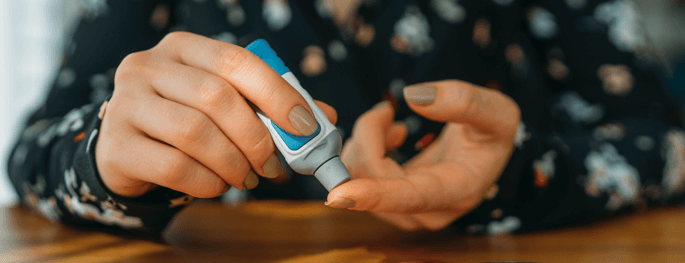

MANAGING DIABETES
Knowing your medicine

Living with type 1 diabetes means getting to know insulin.
InsulinInsulinA hormone made by the beta cells in the pancreas that helps glucose move from the blood into the cells. Insulin is also an injectable medicine that is used to treat diabetes by controlling the level of glucose in the blood. is the main type of medicine that most people with type 1 diabetes take. In type 1 diabetes, the pancreasPancreasA large organ behind the stomach. The pancreas not only makes pancreatic juices, or enzymes, to help the body digest food, but it also makes hormones such as insulin and glucagon, which are important for glucose metabolism. (the organ that usually makes insulin in the body naturally) makes little or no insulin. Insulin helps glucose in the blood get into the cells where it can be used for energy. Without enough insulin, glucose can’t get into your cells where it is needed. Instead, this unused glucose builds up in the bloodstream where it can cause damage. Over time, that can lead to diabetes-related health problems. If people with type 1 diabetes are not treated, high blood glucose can make them very ill.
People with type 1 diabetes need to replace the insulin the pancreas no longer makes. They can do this by taking insulin using:

- An insulin pen
- A vial and syringe
- An insulin pump
- An inhaler (for adults only)
While most people taking insulin use insulin pens or a traditional vial and syringe, insulin pumps are becoming more popular.
If you have type 1 diabetes, you will need insulin coverage 24 hours a day, 7 days a week, 365 days a year in order to control blood glucoseBlood glucoseThe main sugar found in the blood, and the body’s main source of energy.. In fact, most people with type 1 diabetes either need to take multiple daily injections of insulin or continuous insulin infusion using an insulin pump. They also need to monitor their blood glucose using frequent blood glucose checks or by wearing a CGM (continuous glucose monitor). Blood glucose checks throughout the day and night are the best way to do this.
The goal of insulin therapy is to provide the body with replacement insulin in a pattern that matches the way the pancreas would release insulin in someone who does not have diabetes. The amount of insulin taken must be balanced with food and physical activity. In fact, eating, moving, treating, and tracking progress are the 4 cornerstones of good diabetes care.
Different types of man-made insulin are available for people with type 1 diabetes. They are not all the same.
The first generation of man-made insulin, created in the 1980s, was called “human insulin.” It’s actually made in a lab, but is genetically the same as what the body makes. By the late 1990s, man-made insulin analogs were being developed. Insulin analogs are similar to regular human insulin, but they are changed slightly to act faster or slower than regular human insulin. This allows them to more closely match how the body would release insulin.
Each type of insulin analog works differently
Each type of insulin has:
A specific time when it starts to work (called onset of action)
A time it takes to reach its greatest effect on blood glucose (called time to peak action)
A time when it is actively working in the body (called duration of action)

There are 3 types of insulin analogs available:

- Long-acting. This type works more slowly. It works longer to control blood glucose between meals and when you sleep. Long-acting insulin is taken either once or twice a day at the same time every day, giving you coverage throughout the day and night.
- Fast-acting (or rapid-acting). This type is taken shortly before meals to control the rapid rise in blood glucose from eating. Fast-acting insulin more closely mimics the body’s release of insulin at meals compared with long-acting insulin. It works quickly to control the rise in blood glucose after meals.

- Premix. This type of insulin combines the action of a fast‑acting and a long‑acting insulin in 1 injection, usually taken 1 to 3 times a day.
Each type of insulin is used to control blood glucose in people with diabetes. But no one type is right for everyone. Each person’s insulin need is different. And each person’s insulin need may change over time.
According to recommendations from the American Diabetes Association, most people with type 1 diabetes should use insulin analogs to reduce the risk of hypoglycemia (low blood glucose). However, all types of insulin, including analogs, have the risk of low blood glucose.
Your doctor will prescribe the insulin that is best for you.
Talk to your doctor about how to use insulin and about the risks and benefits of insulin therapy.
Let your doctor know about all the medicines you are taking, even vitamins and herbal remedies, because some medicines don’t work as effectively when they are mixed with others.



